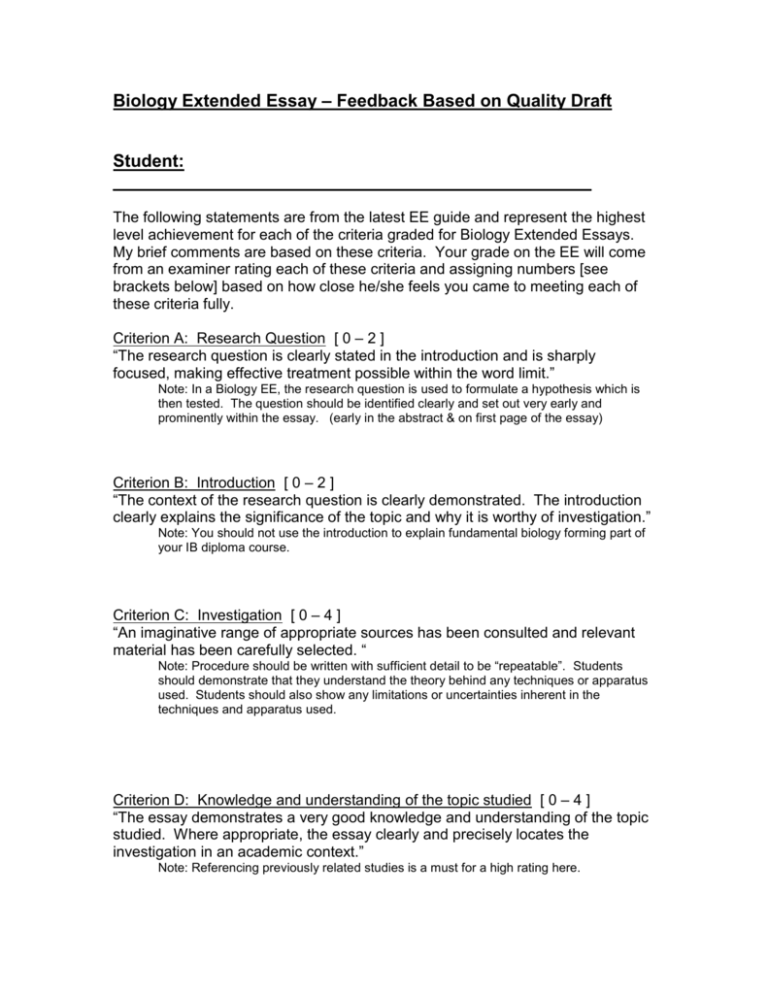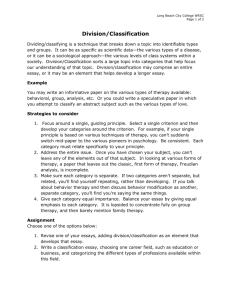Biology Extended Essay – Feedback Based on Quality Draft
advertisement

Biology Extended Essay – Feedback Based on Quality Draft Student: _________________________________________________ The following statements are from the latest EE guide and represent the highest level achievement for each of the criteria graded for Biology Extended Essays. My brief comments are based on these criteria. Your grade on the EE will come from an examiner rating each of these criteria and assigning numbers [see brackets below] based on how close he/she feels you came to meeting each of these criteria fully. Criterion A: Research Question [ 0 – 2 ] “The research question is clearly stated in the introduction and is sharply focused, making effective treatment possible within the word limit.” Note: In a Biology EE, the research question is used to formulate a hypothesis which is then tested. The question should be identified clearly and set out very early and prominently within the essay. (early in the abstract & on first page of the essay) Criterion B: Introduction [ 0 – 2 ] “The context of the research question is clearly demonstrated. The introduction clearly explains the significance of the topic and why it is worthy of investigation.” Note: You should not use the introduction to explain fundamental biology forming part of your IB diploma course. Criterion C: Investigation [ 0 – 4 ] “An imaginative range of appropriate sources has been consulted and relevant material has been carefully selected. “ Note: Procedure should be written with sufficient detail to be “repeatable”. Students should demonstrate that they understand the theory behind any techniques or apparatus used. Students should also show any limitations or uncertainties inherent in the techniques and apparatus used. Criterion D: Knowledge and understanding of the topic studied [ 0 – 4 ] “The essay demonstrates a very good knowledge and understanding of the topic studied. Where appropriate, the essay clearly and precisely locates the investigation in an academic context.” Note: Referencing previously related studies is a must for a high rating here. Criterion E: Reasoned argument [ 0 – 4 ] “Ideas are presented clearly and in a logical and coherent manner. The essay succeeds in developing a reasoned and convincing argument in relation to the research question.” Note: A clear and logical argument is in part achieved by making repeated reference to the research question and to the hypothesis derived from it. Criterion F: Application of analytical and evaluative skills appropriate to the subject [0–4] “The essay shows effective and sophisticated application of appropriate analytical and evaluative skills.” Note: Tables of raw data does not achieve this criterion. Raw data must be processed, presented and analyzed in a way that relates clearly to the central argument of the essay. This analysis should allow for an assessment of the validity of the hypothesis. Errors and uncertainties arising from the methodology , instruments, and techniques should be analyzed and critically evaluated. Criterion G: Use of language appropriate to the essay [ 0 – 4 ] “The language used communicates clearly and precisely. Terminology appropriate to the subject is used accurately, with skill and understanding.” Note: Student must maintain a consistent linguistic style throughout the essay. Any technical terms should be clearly explained and used appropriately in the essay. Criterion H: Conclusion [ 0 – 2 ] “An effective conclusion is clearly stated; it is relevant to the research question and consistent with the evidence presented in the essay. It should include unresolved question where appropriate.” Note: Biological research often reveals unexpected outcomes and these should be pointed out, even if they were not part of the original plan. The original research question is often only partially resolved by the conclusion. The unresolved issues and suggestions for further investigations is thus even more important. Criterion I: Formal Presentation [ 0 – 4 ] “The layout, organization, appearance and formal elements of the essay consistently follow a standard format. The formal elements include: title page, table of contents, page numbers, illustrative material, quotations, documentation (references, citations, and bibliography) and appendices (if used). Note: Biological investigations often require the support of diagrams or drawings. Care must be taken to supply references for illustrations taken from sources. Illustrative material should be used only to enhance the argument of the essay. Drawings, photographs, etc. without labels are unlikely to enhance the essay. Criterion J: Abstract [ 0 – 2 ] “The abstract clearly states the research question (and hypothesis), how the investigation was undertaken and the conclusion(s) and does so under 300 words.” Note: Make sure to include a description of the methodology and the scope of the study. Criterion K: Holistic judgment [0–4] Note: This criterion is left open for examiners to reward those essays that are thought to be superior in many ways, but not necessarily rewarded by the other criteria. Examiners look for such things as: Student making a convincing argument as to why the topic/question was chosen Use of novel or innovative approaches Unusual insights and depth of understanding Originality and creativity









